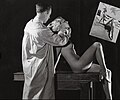Portal:Nudity
Introduction

Nudity is the state of being in which a human is without clothing. While estimates vary, for the first 90,000 years of pre-history, anatomically modern humans were naked, having lost their body hair and living in hospitable climates. As humans became behaviorally modern, body adornments such as jewelry, tattoos, body paint and scarification became part of non-verbal communications, indicating a person's social and individual characteristics. Indigenous peoples in warm climates used clothing for decorative, symbolic or ceremonial purposes but were often nude, having neither the need to protect the body from the elements nor any conception of nakedness being shameful. In many societies, both ancient and contemporary, children might be naked until the beginning of puberty. Women may not cover their breasts if they were associated with nursing babies more than with sexuality.
In the ancient civilizations of the Mediterranean, from Mesopotamia to the Roman Empire, proper attire was required to maintain social standing. The lower classes might possess a single piece of cloth that was wrapped or tied to cover the lower body; the lowest classes including slaves might be naked. However, through much of Western history until the modern era, people of any status were also unclothed by necessity or convenience when engaged in labor and athletics; or when bathing or swimming. Such functional nudity occurred in groups that were usually but not always segregated by sex. Although improper dress might be socially embarrassing, the association of nudity with sin regarding sexuality began with Judeo-Christian societies, spreading through Europe in the post-classical period. Traditional clothing in temperate regions worldwide also reflect concerns for maintaining social status and order, as well as by necessity due to the colder climate. However, societies such as Japan and Finland maintain traditions of communal nudity based upon the use of baths and saunas that provided alternatives to sexualization.
The spread of Western concepts of modest dress was part of colonialism, and continues today with globalization. Contemporary social norms regarding nudity reflect cultural ambiguity towards the body and sexuality, and differing conceptions of what constitutes public versus private spaces. Norms relating to nudity are different for men than they are for women. Individuals may intentionally violate norms relating to nudity; those without power may use nudity as a form of protest, and those with power may impose nakedness on others as a form of punishment. (Full article...)
Selected general article
A stripper or exotic dancer is a person whose occupation involves performing striptease in a public adult entertainment venue such as a strip club. At times, a stripper may be hired to perform at private events.
Modern forms of stripping minimize the interaction of strippers with customers, reducing the importance of the tease in the performance in favor of speed of undress (the strip). Not all strippers are comfortable dancing topless or fully nude, but in general, full nudity is common where not prohibited by law. The integration of the burlesque pole as a frequently used prop has shifted the emphasis in the performance toward a more acrobatic, explicit form of expression compared to the slow-developing burlesque style. Most strippers work in strip clubs. A house dancer works for a particular club or franchise, while a feature dancer typically has her own celebrity, touring a club circuit and making appearances. Strippers are often not direct employees of clubs but instead perform as independent contractors.
Before the 1970s, strippers in Western cultures were almost invariably female, performing to male audiences, usually in strip clubs. At the same time, strippers of all genders were dancing in underground clubs or as part of a theatre experience. Since the 1970s, mainstream stripping has adopted a greater gender diversity and male strippers have become an established form of entertainment for female audiences. Their performances are usually fully choreographed, involving dance routines and costumes. Certain male and female strippers also perform for LGBT audiences as well as for all genders in bisexual contexts. The term "male stripper" has decreased in use in books published in the 21st century. (Full article...)
Did you know...
- ... that two nude bathers in Arnold Comes of Age were "nearly obliterated"?
- ... that Ettore Sottsass's design of the Olivetti Valentine typewriter was inspired by the pop-art nudes of Tom Wesselmann?
- ... that Meghan Trainor was inspired to write "Made You Look" after her therapist asked her to look at herself naked for five minutes?
- ... that sales from Dieux du Stade, a nude calendar produced by the French professional rugby union club Stade Français featuring photos of its players, helped to finance the club for many years?
- ... that after women's suffrage in Switzerland was approved in a referendum in 1971, the tabloid Blick sported a cover with a naked blonde and the headline "Thank you for the Roses"?
- ... that the destroyed plinth of Gürdal Duyar's nude sculpture Güzel İstanbul contained reliefs of a fig, a pomegranate, a honeysuckle and a bee to represent different aspects of Istanbul?
- ... that according to one Turkish artist, a nude sculpture by Gürdal Duyar almost dissolved the 37th government of Turkey?
- ... that Chris Ernst stripped naked in 1976 with her Yale University teammates to protest the lack of showers for the women's rowing crew?
Need help?
Do you have a question about Nudity that you can't find the answer to?
Consider asking it at the Wikipedia reference desk.
Get involved
For editor resources and to collaborate with other editors on improving Wikipedia's Nudity-related articles, see WikiProject Nudity.
Subtopics
Associated Wikimedia
The following Wikimedia Foundation sister projects provide more on this subject:
-
Commons
Free media repository -
Wikibooks
Free textbooks and manuals -
Wikidata
Free knowledge base -
Wikinews
Free-content news -
Wikiquote
Collection of quotations -
Wikisource
Free-content library -
Wikiversity
Free learning tools -
Wiktionary
Dictionary and thesaurus









































































